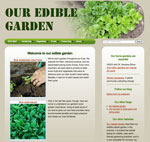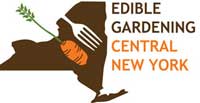| We can make a difference |  |
Increasing the percentage of natives in suburbia is a grassroots solution to the extinction crisis ...
Our success is up to each one of us individually. We can each make a measurable difference almost immediately by planting a native nearby.
As gardeners and stewards of our land, we have never been so empowered--and the ecological stakes have never been so high.
~ Douglas Tallamy,
Bringing Nature Home
|
Spring Cleanup
|
 | | Columbine coming up through leaves |
|
Don't go overboard with that spring cleanup! Leaves will simply decay, further enriching the soil. (Of course, this doesn't apply to lawn.) After breaking off old flower stalks, the stubby remains will soon be hidden by new growth. Protect the life hidden there in the remains of last year's garden. Read more about one gardener's experiences ...
|
| Our Habitat Garden |  |
Visit Our Habitat Garden website for information on providing habitat, earth-friendly gardening practices, plants, and various creatures here in Central New York. |
| HGCNY on Facebook |
As as more of us participate on our Facebook page, this will become a useful resource for asking (and answering!) local HGCNYers' questions about habitat gardening. Join in what can become a very useful conversation about habitat gardening in Central New York.
|
|
Join HGCNY!
|  |
Becoming an official member of HGCNY is easy: just join Wild Ones! When you're a Wild Ones member, you're automatically an official member of HGCNY. |
| Our Edible Garden |  | | Visit OurEdibleGarden.org to see an example of a Central New York edible garden, the perfect companion to your habitat garden. |
| Interested in Edible Gardening? | 
|
If you'd like to get information on Edible Gardening CNY, just email John to find out about edible gardening tours and programs.
|
|
Greetings!
 Our tenth anniversary! Our tenth anniversary!HGCNY started in March of 2002. Thank you to all the many people who have helped along the way!
 Cedars, Samphire, Sassafras: Cedars, Samphire, Sassafras:
Historical Plants of Onondaga Lake
We're pleased to have Catherine Landis of SUNY-ESF at our 10th anniversary meeting to share the history of plants in one of Central New York's defining features: Onondaga Lake.
What was Onondaga Lake like before becoming a sink for pollutants? What plant communities could be found growing around it? What were the cultural connections to these places and plants? In this program we will explore these questions, beginning with post-glacial settings and moving up to the 1800s. This story of place will be woven from clues in sediment cores, old maps, missionary and explorers' journals, botanical records and other sources.
WHEN: Sunday, March 25 at 2:00 PM
WHERE: Liverpool Public Library (Directions)
Free and open to the public.
Come and bring a friend!
~ Janet Allen
|
|
 HGCNY 2012 Native Plant Shopping Guide "But where do I find native plants?"
This is one of our most frequently asked questions!
To help you find native plants in the CNY area, we've compiled a list of native plants offered by several local nurseries. We have been surprised to see that there are many more species offered than we suspected, which is very good news.
This guide will soon be available both in hardcopy and in online versions. In fact, we hope to have them available at this Sunday's meeting (though we aren't promising this ...)
|
 | | Toad singing
(May 2009)
|
An early spring
Every year we eagerly await what we think of as the first real sign of spring: toads calling for mates. As curmudgeonly as a toad may look, it has a beautiful trilling song that we enjoy. (Hear it on eNature.) But we were shocked to hear this song this past Sunday (March 18), an 80 degree, record-breaking day, 8 degrees higher than the previous record for that date. March 18 is also ten days earlier than the earliest date I had heard toads singing in previous years. What other changes are happening?You can be a citizen scientist and help collect data that tracks these changes year by year. Project BudBurst is a network of people across the U.S. who monitor plants as the seasons change, noting when various life cycle milestones occur. It's easy to participate, and it could make a good family project (not to mention an educational project for schools).
 | Virginia bluebells (Mertensia virginica) is one of the plants on the list
|
How you can participateSelect the plants you wish to monitor from the list of wildflowers, grasses, evergreens, and so on, provided. Then check these plants three times a week to see if they've reached any of the specified "phenophases," for example, "first ripe fruit." Mark the date each phase occurs, then report on the Project Budburst website. (The website gives all the details you need to know.) More plants and animals, tooIf you want to include the life cycle phases of animals, too, or wish to track a larger array of plants, check out Nature's Notebook, a project of the USA National Phenology Network. Help rescue historical bird informationThousands of volunteers for the North American Bird Phenology Program are helping scan and transcribe six million data cards tracking bird movements from the late 1800s to the mid-1900s. Unless these cards are digitized in some standard format, we'll lose this treasure trove of data, carefully collected by so many people over so many years--perhaps by some of your own ancestors! Though transcribing these records may sound boring, it's actually an interesting, rather relaxing activity for times when you have a few extra minutes. |
Preventing bird-window collisions
 | |
Yellow-rumped warbler, a common migrant
|
FLAP (Fatal Light Awareness Program) has some tips on preventing bird-window collisions at home.
What does NOT work:
1) hawk silhouettes
2) single window decals
3) noise deterrents
4) plastic owls
5) magnetic fields
What DOES work:
1) applying decals in a dense pattern 2) various types of window films 3) window screening or netting 4) ribbons or strings 5) whitewashing your windows 6) moving your birdfeeders 7) moving your houseplants 8) closing curtains and blinds But these work only if they're implemented correctly. For example, moving your birdfeeders closer (less than 1-1/2 feet) to the window is recommended. Read more about these methods...Cornell's Lab of Ornithology has some additional suggestions such as attaching branches in front of windows or even installing windows facing slightly downward so they reflect ground, not sky. Although some of these measures may seem extreme, it's generally just a few windows that cause a problem and sometimes just during migration season. How to help window collision victims- Advice from Cornell's Lab of Ornithology: * Place the bird in a dark container with a lid and leave it somewhere warm and quiet, out of reach of pets and other predators. * Do not try to give it food and water, and resist handling it as much as possible. * Release it outside as soon as it appears awake and alert. * If the bird doesn't recover in a couple of hours, take it to a veterinarian or wildlife rehabilitator. Read more from Cornell's Lab of Ornithology...
|
|
Geese: resident or migratory?
 | |
Photo: Daniel D'Auria / Wikipedia
|
Though many people assume that some geese just decide to stick around and others decide to head for other climates, these are actually two different types of geese.
This 2-minute video from SUNY-ESF explains the differences between the smaller migrating geese and the larger resident geese.
Whether resident or not, some people prefer not to have them around -- even as they're providing the perfect conditions for them. These perfect conditions include large lawn areas that provide food and opportunity to easily see predators. Though some communities choose to kill geese, there are many other, more humane and ultimately more effective solutions. Read more ...
|
|
|
|
|